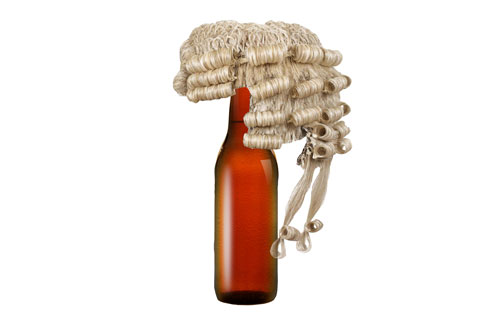We'll Never Be That Drunk Again

One day in 1874, Philip Kock was testifying in a Brooklyn court. There were no charges laid against him; he was appearing as an expert on the effects of lager beer. Kock had drunk 30 quarts of the stuff in one sitting on a bet. According to court transcripts, Kock wasn't intoxicated in the least. In fact, he said he felt "comfortable" and would frequently drink from sixty to ninety glasses a day when he was "flush".
At this point, it seems like the math might be wrong, or we might be talking about some weird 1874 units. Just to be clear, 30 quarts is roughly 28 litres, which is the same as 56 pints, or roughly 83 modern bottles, and Kock drank that in under two hours. I'm not sure how that is even possible, but the same court transcripts cite loads of other American gentlemen who regularly drank over fifty glasses of lager a day. The judge himself stated that 7 or 8 pints per person is common.
The court was debating whether it was possible to get drunk on lager, and evidence strongly pointed towards the notion that it was not. The court heard several testimonies like Kock's, as well as that of chemist James R. Chilton, who had analyzed lager and found it to contain about four per cent alcohol, which by his estimation could not intoxicate unless drunk in "extraordinary quantities."
I suppose one person's drunk is another's sober; Americans in the mid-1800s drank three times as much hard liquor as they do now. Beer critic Randy Mosher wrote about the same court proceedings in his book Radical Brewing. "It is interesting to try to grasp what they must have meant by 'intoxicated,'" Mosher said.
In those days, being drunk was normal behaviour for anyone that had the money to procure the booze. And those with more money got more drunk.
In a recent article called "The Demon Drink," Time writer David von Drehle says many of America's forefathers were "three sheets to the wind" as they laid the groundwork of the Constitution. "John Adams drank hard cider with breakfast," says Drehle. "James Madison drained a pint of whiskey each day." Countries and entire continents before the 20th century were governed by powerful, drunk men.
And if the Americans were drunk when they wrote the Constitution, imagine what must have been going on north of the border. Canada has had its roots soaking in booze since the early days. Sir John A. MacDonald was famous for his unrestrained boozing, and is known to have vomited mid-speech, only to regain his composure and continue on wittier than before. According to MacDonald's biographer Richard Gwyn, his entire character, both private and public, was defined by heavy drinking. It should be mentioned though that Canada's first prime minister preferred stronger drinks—champagne, claret, port and brandy—to the lighter lagers, which likely just didn't get the job done.
While MacDonald was in the autumn of his political career, puking and spitting his way through every ordeal, Thomas Hardy was at work writing The Mayor of Casterbridge across the pond. It was first published in 1886, and was by some accounts the first novel about alcoholism. Times were catching up with all the old, powerful drunks, and what was once the essential fortifying element of our leaders became known as a disease.
Those were the days before prohibition, and the women's temperance movement was just starting to gain momentum (possibly the reason there was any court debate at all over alcohol). Not coincidentally, women's rights like the right to vote became more widespread as men's guzzling of alcohol came under increasing public criticism. Ironically, it was MacDonald who tabled a bill in 1884 that would have allowed women to vote in Canada. The House later defeated the bill, but in his moments of sobriety, it was clear that MacDonald recognized the importance of women's rights, and the usefulness of getting off booze. MacDonald had in fact joined a temperance league some twenty years earlier, but failed to dry out at all.
At the time of Kock's testimony, the idea of temperance itself was in transition. In the early 1800s, the temperance movement was simply advocating for levelness, rather than abstinence for alcohol, but by the turn of the century, the movement had become much more extreme. Instead of lobbying men to curb their benders to five litres each, the Women's Christian Temperance Union put the wheels in motion towards absolute abstinence near the end of that century.
It's hard to overestimate the power that booze holds over our collective consciousness. How many of our most important personal decisions are made over a pint, or several? The same is true for the most elemental structures of our governments. And in thinking about how to solve the problems that plague us now, maybe they would make more sense if we looked through beer goggles.
Related on maisonneuve.org:
—My Life in Dépanneurs
—Places to Drink Outside in Halifax
—When Writers Drink
Subscribe — Follow Maisy on Twitter — Like Maisy on Facebook





